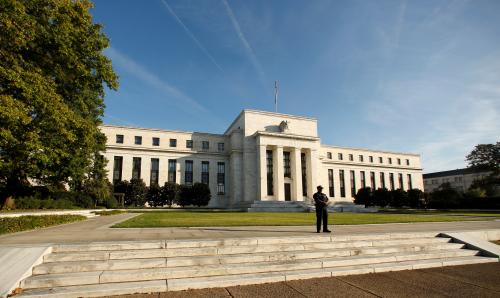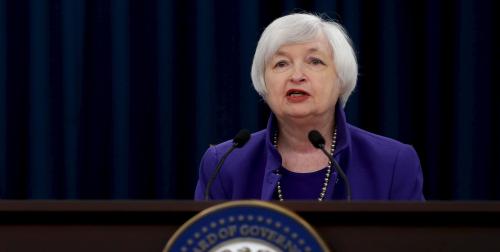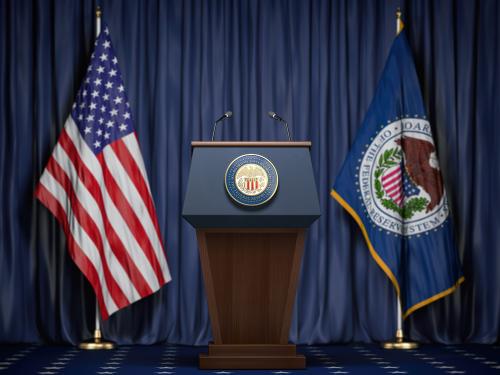Olson is a research analyst at the Hutchins Center on Fiscal and Monetary Policy at the Brookings Institution. Wessel is director of the Center and a contributing correspondent to The Wall Street Journal.
The Federal Reserve will release its latest Summary of Economic Projections (SEP) on Wednesday (Dec. 14), with estimates for GDP growth, inflation, unemployment and, of most interest to financial markets, the “dots”—the often-criticized plot of short-term interest rates made by each of the 17 current monetary policy makers. (There are two vacancies on the Federal Reserve Board.) In a recent Hutchins Center survey of academic and market Fed watchers, only 33% of those surveyed deemed the dots “useful” or “extremely useful.” Dot critics say that they create more confusion than clarity and are often (and incorrectly) seen by markets as a commitment by the Fed as opposed to each policymaker’s view of the appropriate monetary policy given the policymaker’s own economic projections. Dot defenders say that, if properly interpreted, the dots provide a rough view of the FOMC’s reaction function—how it changes monetary policy in response to economic developments.
Ben Bernanke, our Brookings colleague who was Fed chair when the Federal Open Market Committee began publishing the dots in 2012, acknowledges that they require careful interpretation: The projections are not a commitment, they are not estimates of what the committee will do, they do not emphasize the uncertainty inherent in such an exercise. He called them the “advanced level of the video game” and suggested that “If you haven’t made it past the first 12 levels, forget about the dot plot.” But, he argued, in their current form they do “provide useful information about the views of FOMC participants and the factors that condition their policy preferences.”
We’ve been soliciting suggestions for the Fed from academic and private-sector Fed watchers and from former Fed officials. Here is some of what we’ve heard:
Proposal 1: Replace the dots with a consensus forecast
Most other major central banks, including the European Central Bank and the Bank of England, release a staff or consensus forecast for unemployment, inflation and GDP. (The exception is the Bank of Japan, which, like the Fed, releases economic projections—though not interest rate projections—from each member of its monetary policy committee.) So why don’t Fed policymakers release a staff forecast or agree on a consensus forecast of their own? Why publish 17 different forecasts?
The answer lies partly in the Fed’s unique structure. The seven-member Board of Governors in Washington and each of the 12 regional Federal Reserve banks have their own research staffs with varying forecasting models and perspectives. Getting everyone to agree on a single consensus forecast is consequently very difficult, particularly because the FOMC is an unusually large committee with 19 members when at full complement.
Ben Bernanke recalls that the FOMC attempted to produce a consensus forecast back in 2012, but “given the large size of the committee and the disparate views represented,” it was “unable to agree on a procedure for developing such a forecast in a timely way.” Still, he thinks there’s potential there, mentioning it as a possible way forward if it can be done.
Proposal 2: Stop highlighting the median of the dots
Given the 17 interest-rate projections to published by the Fed this week, anyone can easily determine what the median – or middle – projection is, but in September 2015, the Fed began supplementing the presentation by displaying that information explicitly. Some have suggested that promoting use of the median as a summary statistic is unwise or misleading because it can deemphasize the uncertainty surrounding the projections and lead to their being taken out of context.
Don Kohn., a former Fed vice chair who is now our colleague at Brookings, is one of those who thinks the practice should be done away with. “Stop publishing the median of the dots,” he has written. “It is not necessarily a good representation of the committee’s center of gravity given the small size of the FOMC, and it greatly increases attention to a narrow path for rates.”
At a recent Hutchins Center conference, Jerome Powell, a member of the Board of Governors, agreed that the median is of limited usefulness. When asked about it at the Hutchins Center conference, he said he “wouldn’t want to put too much on it.”
Proposal 3: Identify which FOMC member submitted each dot
Presently, all of the SEP’s forecasts are anonymous, but some think each committee member’s submission should be identified. This would reveal how each individual views the economy and appropriate course of policy, making each person accountable and forcing him or her to be more thoughtful about the forecast. It also would reveal how individual policymaker’s views change over time. The concern among FOMC members is that it would complicate the committee’s internal debate. The public would likely focus a great deal on the Chair’s estimated path and ignore the others, making realized policy seem like a referendum on whether the chair “won” or “lost.”
Proposal 4: Link each dot with its corresponding economic forecast
The Fed currently displays the SEP forecasts for growth, unemployment, inflation and the “appropriate path” of interest rates separately, without linking a policymaker’s economic forecast to his or her interest-rate projection. Without identifying each person, the Fed could show how each individual projects each of the four variables. Identifying which dots match each economic forecast would “give observers an opportunity to infer individual participants’ reaction functions; it should help economic agents to infer the Committee’s reaction function more accurately than simply looking at median of multiple forecasts,” Don Kohn has written.
There is considerable support for this change. At the Hutchins Center’s conference, Peter Hooper (of Deutsche Bank), Vincent Reinhart (chief economist for Standish Mellon Asset Management) and Roberto Perli (head of global monetary policy research for Cornerstone Macro) expressed support for it.
Tying the dots to the economic forecasts in the SEP could help resolve a source of confusion that Johns Hopkins professor and former Fed adviser Jon Faust has identified as one of the SEP’s biggest problems. Presently, with the interest-rate forecasts divorced from the economic forecasts, it isn’t clear why a member who thinks the Fed should raise rates in a year feels that way. Is it because he or she believes significant inflation will materialize next year? Or is it because he or she thinks the labor market will be too tight next year, and wants to raise rates pre-emptively to fend off inflation two years down the road? Or is the story another one entirely? With this approach, it will be apparent both what individual committee members are expecting to happen in the real economy, and how they think the Fed should react.
Proposal 5: Display uncertainty
Many central banks, including the European Central Bank and the Bank of England, display uncertainty bands around their GDP and inflation forecasts. Some have suggested the FOMC do this with its interest rate projections, arguing that the wide bands would discourage people from taking the median of the dots as a policy commitment.
At her Jackson Hole speech this summer, Chair Yellen provided an example of how this could be done:

Jon Faust thinks that if the median is getting “too much attention,” then “making the lines blurrier can’t be a bad thing,” but it’s not clear how to do this well because the center of the forecast is a median, not a mean. “Just putting some sort of uncertainty bands around pictures that are premised on different modal outlooks is difficult to interpret.” And as noted by Alan Blinder, a Princeton economics professor and currently a visiting fellow at Brookings, fan charts are hard to read. “One consequence of that is people just look at the middle,” he said. This could lead, perversely, to further emphasis on the median.
Proposal 6: Present results under alternative economic scenarios
Committee members could agree to submit dots under various economic scenarios—a supply shock that brings down oil prices, for example—that would change each quarter. This would presumably help the public understand how the committee is likely to react to such shocks, and also give the public a sense of the various shocks the committee is contemplating.
FOMC minutes reveal that it considered something along these lines back in 2012:
A staff presentation provided an overview of an exercise that explored individual participants’ views on appropriate monetary policy responses under alternative economic scenarios… Possible benefits include helping to clarify the factors that individual participants judge most important in forming their views about the economic outlook and their assessments of appropriate monetary policy… Some participants stated that exercises using alternative scenarios, with appropriate adjustments, could potentially be helpful for internal deliberations and, thus, should be explored further. However, no decision was made at this meeting regarding future exercises along these lines.
The Reserve Bank of India publishes GDP and inflation forecasts under different scenarios in its semi-annual Monetary Policy Report.
Proposal 7: Get rid of the dots altogether
At our recent conference on Fed communications, Julia Coronado, chief economist at Graham Capital Management, argued the dots should be discontinued. Her reasoning: “They aren’t explicit forward guidance, but they sort of presume a sort of direction and speed of travel and convey a level of certainty.” When events turn out differently than predicted by the dots, the Fed loses credibility.
That view is far from universal. “I’m definitely not in the ditch-the-dots camp,” said Deutsche Bank Chief Economist Peter Hooper. “I think they serve a purpose, the cat is out of the bag, it would be awfully difficult to put it back in at this point.” Don Kohn argued that “the dots are here to stay; removing them would be seen as a step back in transparency and, appropriately presented, they can be aids to understanding.”
The Brookings Institution is committed to quality, independence, and impact.
We are supported by a diverse array of funders. In line with our values and policies, each Brookings publication represents the sole views of its author(s).






Commentary
Improving The Fed’s Dots
Tuesday, December 13, 2016